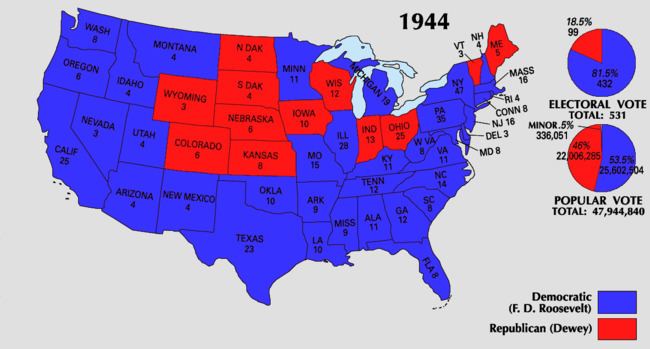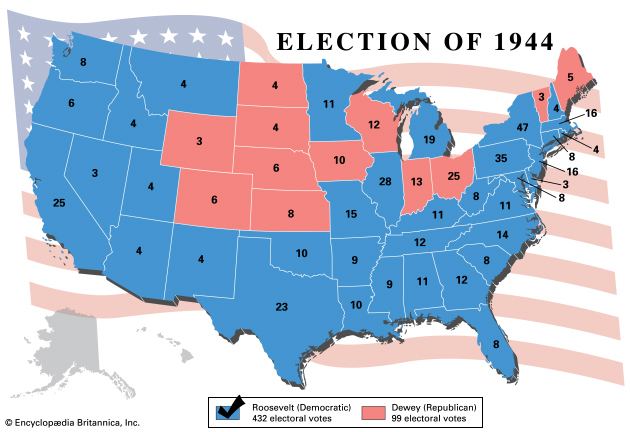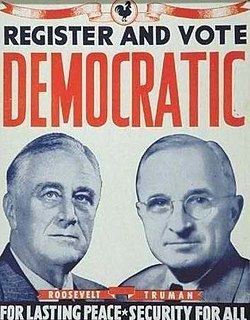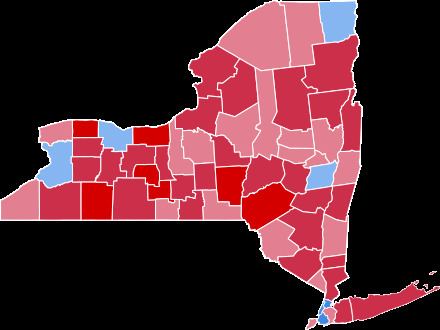November 7, 1944 1948 → 432 99 25,612,916 22,017,929 Date 7 November 1944 | Turnout 55.9% 6.6 pp 36 12 53.4% 45.9% Location United States of America | |
 | ||
Winner Franklin D Roosevelt Other Instances United States presidenti, United States presidenti, United States presidenti, United States presidenti, United States presidenti | ||
The United States presidential election of 1944 was the 40th quadrennial presidential election, held on Tuesday, November 7, 1944. Incumbent President Franklin D. Roosevelt, the Democratic nominee, sought his fourth term in office; he defeated Republican Thomas E. Dewey in the general election.
Contents
- Democratic Party nomination
- Republican Party
- The fall campaign
- Results
- Close states
- Miscellanea
- References

The election was set against the backdrop of World War II, which was going well for the United States and its Allies. Roosevelt had already served longer than any other president, but remained popular. Unlike in 1940, there was little doubt that he would run for another term as the Democratic candidate. Dewey, the Governor of New York, campaigned against the New Deal and for a smaller government, but was ultimately unsuccessful in convincing the country to change course. Rumors of Roosevelt's ill health, though somewhat dispelled by his vigorous campaigning, proved to be prescient; Roosevelt would die and be replaced by his new Vice President, Harry S. Truman, within a half-year of winning re-election.

Democratic Party nomination
Democratic candidates:

President Roosevelt was the popular, wartime incumbent and faced little formal opposition. Although many Southern Democrats distrusted Roosevelt's racial policies, he brought enormous war activities to the region and the end of its marginal status was in sight. No major figure opposed Roosevelt publicly, and he was re-nominated easily when the Democratic Convention met in Chicago. Some pro-segregationist delegates tried to unite behind Virginia senator Harry F. Byrd, but he refused to actively campaign against Roosevelt, and did not get enough delegates to seriously threaten the President's chances.

The obvious physical decline in the president’s appearance, as well as rumors of secret health problems, led many delegates and party leaders to oppose Vice President Henry A. Wallace strongly for a second term. Opposition to Wallace came especially from Catholic leaders in big cities and labor unions. Wallace, who was Roosevelt’s vice president since January 1941, was regarded by most conservatives as being too left-wing and personally eccentric to be next in line for the presidency. He had performed so poorly as economic coordinator that Roosevelt had to remove him from that post. Numerous party leaders privately sent word to Roosevelt that they would fight Wallace's re-nomination as vice president and proposed instead Senator Harry S. Truman, a moderate from Missouri. Truman was highly visible as the chairman of a Senate wartime committee investigating fraud and inefficiency in the war program. Roosevelt, who personally liked Wallace and knew little about Truman, reluctantly agreed to accept Truman as his running mate to preserve party unity. Even so, many delegates on the left refused to abandon Wallace, and they cast their votes for him on the first ballot. However, enough large Northern, Midwestern, and Southern states supported Truman to give him victory on the second ballot. The fight over the vice presidential nomination proved to be consequential; Roosevelt died in April 1945, and Truman instead of Wallace became the nation’s thirty-third President.
Republican Party

As 1944 began, the frontrunners for the Republican nomination appeared to be Wendell Willkie, the party's 1940 nominee, Senator Robert A. Taft from Ohio, the leader of the party's conservatives, New York Governor Thomas E. Dewey, the leader of the party's moderate eastern establishment, General Douglas MacArthur, then serving as an Allied commander in the Pacific theater of the war, and former Minnesota Governor Harold Stassen, then serving as a U.S. naval officer in the Pacific. Taft surprised many by announcing that he was not a candidate as he wanted to remain in the Senate; instead, he voiced his support for a fellow conservative, Governor John W. Bricker of Ohio.

With Taft out of the race some Republican conservatives favored General MacArthur. However, MacArthur’s chances were limited by the fact that he was leading Allied forces against Japan, and thus could not campaign for the nomination. His supporters entered his name in the Wisconsin primary nonetheless. The Wisconsin primary proved to be the key contest, as Dewey won by a surprisingly wide margin. He took fourteen delegates to four for Harold Stassen, while MacArthur won the three remaining delegates. Willkie was shut out in the Wisconsin primary; he did not win a single delegate. His unexpectedly poor showing in Wisconsin forced him to withdraw as a candidate for the nomination. However, at the time of his sudden death in early October 1944, Willkie had endorsed neither Dewey nor Roosevelt. At the 1944 Republican National Convention in Chicago, Illinois, Dewey easily overcame Bricker and was nominated for president on the first ballot. Dewey, a moderate to liberal Republican, chose the conservative Bricker as his running mate. Dewey originally preferred fellow liberal California Governor Earl Warren, but agreed on Bricker to preserve party unity (Warren became Dewey's vice presidential candidate in the election of 1948). Bricker was nominated for vice president by acclamation.
The fall campaign
The Republicans campaigned against the New Deal, seeking a smaller government and less-regulated economy as the end of the war seemed in sight. Nonetheless, Roosevelt’s continuing popularity was the main theme of the campaign. To quiet rumors of his poor health, Roosevelt insisted on making a vigorous campaign swing in October and rode in an open car through city streets.
A high point of the campaign occurred when Roosevelt, speaking to a meeting of labor union leaders, gave a speech carried on national radio in which he ridiculed Republican claims that his administration was corrupt and wasteful with tax money. He particularly ridiculed a Republican claim that he had sent a US Navy warship to pick up his Scottish Terrier Fala in Alaska, noting that “Fala was furious” at such rumors. The speech was met with loud laughter and applause from the labor leaders. In response, Dewey gave a blistering partisan speech in Oklahoma City, Oklahoma, a few days later on national radio, in which he accused Roosevelt of being “indispensable” to corrupt big-city Democratic organizations and American Communists; he also referred to members of Roosevelt's cabinet as a “motley crew”. However, American battlefield successes in Europe and the Pacific during the campaign, such as the liberation of Paris in August 1944 and the successful Battle of Leyte Gulf in the Philippines in October 1944, made Roosevelt unbeatable.
Results
Throughout the campaign, Roosevelt led Dewey in all the polls by varying margins. On election day, the Democratic incumbent scored a fairly comfortable victory over his Republican challenger. Roosevelt took 36 states for 432 electoral votes (266 were needed to win), while Dewey won twelve states and 99 electoral votes. In the popular vote Roosevelt won 25,612,916 (53.4%) votes to Dewey's 22,017,929 (45.9%).
The important question had been which leader, Roosevelt or Dewey, should be chosen for the critical days of peacemaking and reconstruction following the war’s conclusion. A majority of the American people concluded that they should not change from one party, and particularly from one leader. They also felt that in view of ever-increasing domestic disagreements it was not safe to do so in “wartime”.
Dewey did better against Roosevelt than any of Roosevelt’s previous three Republican opponents: Roosevelt’s percentage and margin of the total vote were both less than in 1940. Dewey also gained the personal satisfaction of finishing ahead of Roosevelt in his hometown of Hyde Park, New York, and ahead of Truman in his hometown of Independence, Missouri. Dewey would again become the Republican presidential nominee in 1948 and would again lose, though by a slightly smaller margin.
Of the 3,095 counties/independent cities making returns, Roosevelt won in 1,751 (56.58%) while Dewey carried 1,343 (43.39%). The Texas Regular ticket carried one county (0.03%).
In New York, only the combined support of the American Labor and Liberal parties (pledged to Roosevelt but otherwise independent of the Democrats so as to keep separate their identity) enabled Roosevelt to win the electoral votes of his home state.
In 1944, the constantly growing Southern protest against Roosevelt’s leadership became clearest in Texas, where 135,553 votes were cast against Roosevelt but not for the Republican ticket. The Texas Regular ticket resulted from a split in the Democratic party in its two state conventions, May 23 and September 12, 1944. This ticket represented the Democratic element opposing the re-election of President Roosevelt, and called for the “restoration of states' rights which have been destroyed by the Communist New Deal” and “restoration of the supremacy of the white race”. Its electors were uninstructed.
As he had in 1940, Roosevelt won re-election with a lower percentage of both the electoral vote and the popular vote than he had received in the prior elections—the second of only three presidents in US history to do so, preceded by James Madison in 1812 and followed by Barack Obama in 2012. Andrew Jackson in 1832 and Grover Cleveland in 1892 had received more electoral votes but fewer popular votes, while Woodrow Wilson in 1916 had received more popular votes but fewer electoral votes.
Source (Popular Vote): Leip, David. "1944 Presidential Election Results". Dave Leip's Atlas of U.S. Presidential Elections. Retrieved August 1, 2005. Source (Electoral Vote): "Electoral College Box Scores 1789–1996". National Archives and Records Administration. Retrieved August 1, 2005.
Close states
Margin of victory less than 1% (25 electoral votes):
- Ohio, 0.37%
Margin of victory less than 5% (165 electoral votes):
- Michigan, 1.02%
- New Jersey, 1.35%
- Wisconsin, 1.80%
- Wyoming, 2.47%
- Pennsylvania, 2.78%
- Missouri, 2.94%
- Illinois, 3.47%
- Idaho, 3.49%
- Maryland, 3.70%
- New Hampshire, 4.24%
- Iowa, 4.50%
- Oregon, 4.85%
- Maine, 4.99%
Margin of victory between 5% and 10% (138 electoral votes):
- New York, 5.01%
- Connecticut, 5.36%
- Minnesota, 5.55%
- Indiana, 5.65%
- Massachusetts, 5.81%
- Colorado, 6.81%
- New Mexico, 7.03%
- North Dakota, 8.35%
- Delaware, 9.11%
- Kentucky, 9.23%
- Nevada, 9.24%
- Montana, 9.35%
- West Virginia, 9.78%
